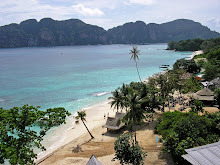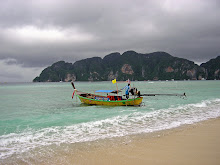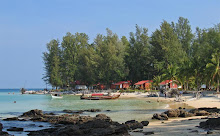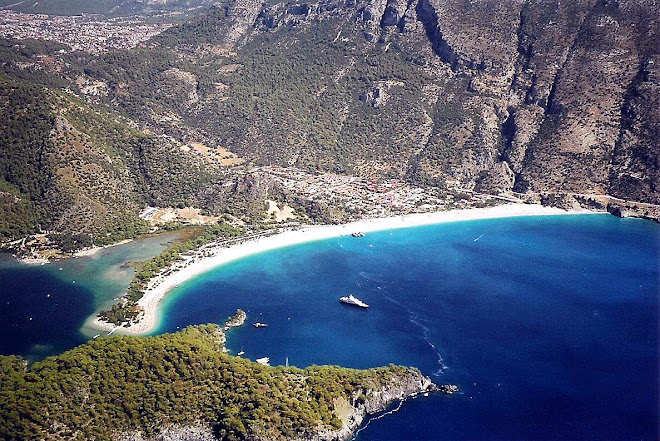THERE IS AN UPDATED VERSION OF THIS PAGE WITH DIAGRAMS AND PHOTOGRAPHS HERE.
Most tourist drownings in Thailand involve people caught in RIP CURRENTS on popular beaches. Phuket and big Ko Chang have the worst records, but rip currents can occur anywhere there is a surf running. All that water heading beachwards has to get back out to sea somehow, and that is the rip current.
Waves in Thailand are more a wet season thing, during and after periods of prolonged strong winds. Waves are absent to very small 99% of dry season.
Inexperienced people finding themselves shooting out to sea in a rip current try to swim against it, get exhausted, take in water, and drown.
THIS SHOULD NEVER HAPPEN! Anyone who can merely tread water, let alone swim, should never drown in a rip.
First DON’T PANIC.
Surfers use rips all the time to take them “out the back” to the take-off zone. They don’t even have to swim. I suggest poor swimmers do exactly the same. ALL rips dissipate in the deeper water just behind the wave breaking zone. They have done their job, and do not go further. The longest rip I have ever seen went 400 meters from the shore in a HUGE SURF, much bigger than anything Thailand gets. Most rips last for 100-150m. Once you are out in the calmer water past the break zone, tread water, put up your hand and wait for someone with a longtail to pick you up.
Treading water is a minimal effort activity, something the average person could do for maybe 24 hours in Thailand before dehydration becomes a problem (the water is too warm for hypothermia). Hell, even TT Thailand’s svelte-challenged and lethargy-enhanced mr. nasty and big time plagiarist of this blog, Singapore Slim (all names changed to protect the guilty) would probably last to dinner time, when the aroma of chips and gravy would force a do-or-die dash for the shore.
DON’T TRY TO SWIM AGAINST THE RIP. A world champion will go backwards against a strong rip. All but very fit swimmers will become exhausted swimming against even gentle rips.
DON’T WORRY ABOUT SHARKS - tens of thousands of surfers and ocean swimmers in Australia and other much sharkier places than Thailand individually spend hundreds of hours yearly swimming and surfing without worries. Hell, I’ve never heard of a shark attack in Thailand, except in that heap of nonsense book by Alex Garland.
DON’T WORRY ABOUT UNDERTOWS - there is no such things as a rip which will drag you under, let alone keep you under.
DON’T WORRY ABOUT WAVES BREAKING ON YOUR HEAD - rip currents move out thru the deeper channels between sandbars - waves break in shallow water (largely on the sandbars) so these deeper channels often have no waves or few waves. If one does come when you are in the rip, take a breath, dive down or duck your head. You are gonna pop up on the other side - that breath guarantees it.
THE OLD SWIM SIDEWAYS TRICK.
Surf-lifesavers in Australia say if you are caught in a rip, SWIM SIDEWAYS TO THE RIP (parallel to the beach). Even big rips are never more than about 30m across, so you will soon move out of the current and hopefully into the shallow water of the sandbar where you can stand**.
I think this is good advice for people who are not exhausted and who start swimming sideways immediately. Wait too long and you are likely to end up on the sandbar but in deeper water, unable to stand up, more exhausted by the swim and with big waves breaking on your head, which can be pretty frightening for the inexperienced. I reckon it is much cooler to allow the rip to take you seaward, then float around out the back waiting for someone to pick you up. It’s nice out there.
HOW TO SPOT A RIP CURRENT.
*Look for the sections where no waves or fewer waves are breaking (note what a trap this is for the inexperienced: “this looks safe, NO WAVES, I’ll swim here”
*Big rips often scour sand as they go and look sandy.
*When the wind is blowing in the opposite direction, the surface of the rip is often disturbed and choppy looking.
Note however, many rips are very difficult to spot from beach or water level.
SOME OTHER FACTS ABOUT RIP CURRENTS
*The bigger the surf, the stronger the rip - there is more water to move back out to sea.
*Rips are strongest at low tide when all that water has to move through a shallower channel; and there is a greater quantity of water to move out because the waves breaking on the shallower sandbars tend to be bigger and more frequent.
*At the ends of beaches there is usually a rip running along at least one of the headlands, maybe both if the swell is coming in exactly front-on to the beach (most swell has a slightly oblique angle of approach).
*A longish beach like Patong or Karon typically has more than a half dozen sandbars separated by channels containing rip currents if surf is running.
*Rips are fed by FEEDER CURRENTS, which run parallel to the beach just off the sand, in the (usually small) channel between the sandbar and the beach. These feeders get stronger as they approach the big channel between the sandbars, where they turn right angles and head out to sea as a full blown rip. Sometimes FEEDER CURRENTS are strong enough towards their ends to drag non/poor swimmers sideways into the rip proper.
Don’t confuse FEEDER CURRENTS with CROSS DRAG and TIDAL CURRENTS which operate further from the beach.
CROSS DRAG or SIDE DRAG:
Most waves approach the beach at a slightly oblique angle - ie not exactly parallel with the beach. This sets up a sideways current (parallel to the beach) known as the LONGSHORE CURRENT, LONGSHORE DRIFT or colloquially, SIDE DRAG, which tends to be located out near the break zone.
Usually this current is not strong, and gives no problems, but if the swell approaches at a bigger angle to the beach and is big, it can be powerful enough to drag swimmers sideways off the sand-bar, and into the rip current in the adjacent channel. It can also be powerful enough to drag the swimmer thru the rip-current and continue on its merry way down the beach.
No problems, just make sure you are not still in the rip-current channel (wait 'til the waves are biggest) and then swim towards shore. The waves will help wash you in.
If you are a poor swimmer and don’t like the idea of getting pounded by breaking waves, just cruise on down the beach and wait for someone to haul you out with a boat. Or swim out to sea a bit, you will move out of the side drag and stay in the one spot.
If you are a NON SWIMMER and get swept sideways off the sandbar, you are gunna drown. But you should have been nowhere near the break zone, which is usually a fair way from shore. Non swimmers should never go in more than thigh deep in any surf, and even then should be aware of the FEEDER CURRENTS mentioned before.
ARE ALL BEACHES DANGEROUS IN WET SEASON?
NO.
Because strong winds in Thailand’s wet season come from the western quadrant, it is usually the WESTWARD FACING BEACHES where the swell can get up, creating sizable surf and dangerous currents.
So unless you are an expert at swimming in big surf, you should avoid such conditions. If you want to cool down, don’t go out more than thigh deep (I’ve found it difficult to walk against a strong rip or side drag in even waist deep water. Sometimes it can be difficult to even stay on your feet).
Good news is that often winds are benign in wet season and the swell stays very small. It's pretty safe to swim on these westward facing beaches in these conditions, although in any surf there will be some type of outward current. There can also be the less troublesome TIDAL CURRENTS I describe later, particularly along any fringing reef and headland. So still be aware.
Another option is to seek an island with EASTERN FACING BEACHES. These beaches are sheltered from the western winds and swell of wet season. Unfortunately, more beaches in the popular Andaman face WEST than east - eg all the good beaches on Phuket, Lanta, Jum. There are nice eastern facing beaches on Phi Phi, Ko Ngai, Ko Kradan, Ko Bulon Lae, Ko Taratao, Ko Lipe.
Away from the Andaman, there are nice eastern facing beaches on Phangan*, Samui*, Tao*, and Samet. The northern beaches at Mak and Ko Whai near big Chang are also pretty sheltered in wet season.
Sadly all of big Chang’s good beaches face west into the wind and swell.
Eastern facing beach areas can be subject to TIDAL CURRENTS, described below.
* ThornTree poster dearsirsam also points out that when the north-east trades get up on island like Samui, Phangan and Tao, so too does the swell, and you can get rip-currents at these beaches. Fortunately in my experience this does not happen too often, mainly in the months Oct thru Dec, but be aware. People have drowned at Thong Nai Pan. And at Hat Rin (and away from the drunken party times).
TIDAL CURRENTS
When the tide rises and falls, water moving into and out of narrow inlets and passages between islands, and over shallow reefs, result in TIDAL CURRENTS. These tend to be strongest mid-tide and usually run parallel to shore.
In places with HUGE tides, they can be awesome, running at 30km+, with associated vortexes (whirlpools) and standing waves of 2m where strong winds blow against them.
In Thailand, the tidal range is not huge and so these currents are not all that strong - as a matter of fact they are good for a no-effort (no need to swim or kick) drift along the edge of a fringing reef checking the coral and fish. When you get tired of that, you swim into the beach, walk back up to the starting point, and repeat as needed.
However, I have seen a few Thai tidal currents which would be difficult for a poorer swimmer to swim against. A Brit guy once told me he found himself being carried along the headland at the south of Hat Rin and had a hell of a time getting back to the beach. At one stage he thought he would not make it.
I reckon poor swimmers should not try. Swim in to the rocks and rock-hop back. If this looks too difficult (sometimes hauling yourself out of the water in rocky areas is near impossible) swim OUT into deeper water. The tidal currents do not run here. Then swim back to the beach in stages, with periodic tread-water rests when needed. Or wait for someone with a boat.
After all this depressing stuff about drowning it’s time for some LIGHT RELIEF, folks:
- **A few years back I saw a girl with the smallest bikini in the world enter the water in what I considered a risky spot at one of my local beaches. Sure enough, she got caught in a rip. She stuck her hand high in the air which is the signal for help in Australian surf.
I just had to haul this lady out personally. Trouble is a skin-diver resting on the adjacent headland rocks figured the same thing. BIG RACE - he had the fins for speed, I had the rip for velocity. I was winning, and only 15 meters from the girl, when suddenly she stood up and walked away! Wise girl had done the sideways-swim trick onto a shallow sand-bar.
- One time I was board-riding Queensland’s Alexander Bay in a big nasty surf. Alexander Bay is popular with surfers and NUDISTS. A girl got caught in a rip and as I paddled across my heart leapt - she was totally gorgeous and would soon be spread-eagled on my board!
She also turned out to be the only girl on the beach wearing swimmers.
Stone the crows trendsetters, sometimes I think Hui, the God of Surf, has a personal grudge against me. And not only in the surf.
Like the time I was doing 130 on the Coolangatta by-pass and the board-racks, containing my full quiver of 5 boards, flew off the roof and was run-over by a tour bus.
Or when I gave a lift from Byron Bay to Sydney to a posse of surfer-groupies who had run out of money to get home. Going thru Ballina, they stuck their cute bare arses out the windows at a couple of cops doing roadside radar duty. The cops radioed their mates down the road, who pulled me over, gave the girls a lecture and me 5 defect notices for the tezza-waggon. Jeez, justice works in strange ways.
Oh yeah, another incident which now makes me smile but wasn’t all that funny in the execution, was the rescue of Johnathon Livingston Seagull from a certain watery death. You can read abt that at the end of my Ko Libong info thingy on this site.
EXTRAS - Thorntree poster ALLY found this pic of a rip at Palm Beach in Sydney. Note how small the surf is. This would be a pretty gentle rip but could still give poor and average swimmers a tough time. Note too how easy it would be to wander off the sand-bar into the deeper channel, not too pleasant for a non swimmer. Note how the rip dissipates "out the back".
Ally also provided this beach-level pic of a rip. His label: "DON'T SWIM BETWEEN THE RED POINTERS!" Once again a pretty small surf. Note how waves are not breaking in the channel.
And some very good pix, a video and info on rips HERE..
If you have any questions, please ask them in THE FORUM rather than below. I don't get a chance to check all threads daily, but unless I'm travelling I'll try to monitor THE FORUM regularly.
-----------------------------------
THERE ARE ACTUALLY 2 BEACHES AND ISLANDS BLOGS (for reasons explained in " About This Site" accessed thru the index) SO THERE ARE MORE BEACH AND ISLAND PAGES HERE
Subscribe to:
Post Comments (Atom)














2 comments:
Excellent post Tezza,
Should be required for all beach visitors in Thailand!
This happens more often in Samui during the rainy season than people will expect, especially with older folks, who don't have the strength or are, unfortunately, ignorant about the right procedures.
Well, Teeza after reading so much educative post about islands in Thailand I would like to quote that I liked Pak Bia island the most and I will certainly include it in my day trip.MK Taxi Service In Shimla - Best Shimla Taxi Service | Shimla Sightseeing Taxi
Post a Comment